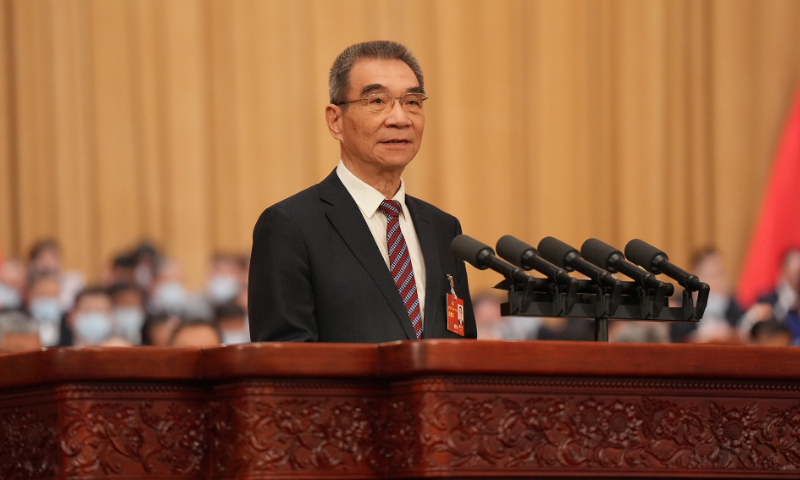Prominent economist Justin Lin debunks 'peak China' claims, highlights China's potential to surpass US

A prominent Chinese economist and a national political advisor has debunked various negative claims about the Chinese economy, including suggestions about "peak China" and "Japanification," while highlighting China's unique advantages and its potential to surpass the US to become the world's biggest economy.
Justin Lin Yifu, dean of the Institute of New Structural Economics at Peking University and a member of the Standing Committee of the Chinese People's Political Consultative Conference (CPPCC) National Committee, the top political advisory body, said that under the current international and domestic economic conditions, China can reach a GDP growth rate of above 5 percent and a potential growth rate of 8 percent.
In a group interview on the sidelines of the ongoing two sessions with reporters from several media outlets, including the Global Times, Lin, the former senior vice president and chief economist of the World Bank, offered firm and sound rebuttals to a series of recent negative claims about the Chinese economy from Western officials and media reports.
The interview came after China's Government Work Report set a GDP growth target of around 5 percent for 2024, underscoring Chinese policymakers' firm confidence in the country's economic recovery, despite the risks and challenges. Such a growth rate means the Chinese economy will remain the fastest-growing among major economies and the main contributor to global growth this year.
"Considering the international and domestic economic conditions, with a potential annual growth rate of 8 percent, it is entirely possible for China to achieve an economic growth rate of above 5 percent," Lin said, pointing to China's various strengths, including a high savings rate, abundant investment resources and resolve to develop its economy.
On China's growth prospects, Lin also pointed out that China, as a major developing economy, is still at the stage of industrial upgrading and still faces a big gap with developed countries, but this creates "a late-comer's advantage." During this catch-up stage, other economies such as Japan, South Korea and Germany achieved a growth rate of 8 percent or above, according to Lin. "If they can achieve that, China also has the potential to achieve it," he said.
While many around the world have highlighted China's vast potential, some Western officials and media outlets have been smearing the Chinese economy recently, with a variety of claims such as "peak China," asserting that the Chinese economy is on a downward trend toward "Japanification," and that it will not catch up with the US.
Lin said that such claims are based on the fact that China's economic growth rate has slowed down and on Japan's experience in the 1980s and 1990s, when its economy lost steam. However, there are key differences between China and Japan back then, Lin said, noting that Japan's technological innovation, industrial upgrading, and productivity improvement during that period had stagnated. China, however, is at the same starting line as developed countries in terms of the new economy. It also has a large pool of talent, a massive market and a complete industrial landscape, Lin noted.
"What happened in Japan will not happen in China. I believe that as long as we continue our technological innovation and industrial upgrading, and improve productivity levels, per capita GDP will grow faster than that of the US," Lin said during the interview.
Another assertion made by Western officials and media outlets is that China will fall into a "middle income trap." But Lin said that China's per capita GDP is already over $12,500, which is very close to the threshold of $13,000 for becoming a high-income nation. "As long as we make good use of the favorable conditions for technological innovation and industrial upgrading, I believe we can become a high-income country - if not in 2025, then 2026," he said.
The economist further noted that with a growth rate of between 5 percent and 6 percent and a potential annual growth rate of 8 percent through 2035, and 3 percent and 4 percent from 2036 to 2050 with a potential growth rate of 6 percent, China's per capita GDP will hit half that of the US by 2049, and considering China's population is four times that of the US, China's economic size will then be twice that of the US, according to Lin. "China will become the world's largest economy and contribute the most to the world economic growth every year," he said.
China's declining population has also become a focal point in the Western media's smearing of the Chinese economy, with some reports even calling it "China's demographic catastrophe."
In the group interview, Lin dismissed such claims, saying that China used to rely on the size of the population, but it now focuses on the quality of the population, having stepped up investment in education.
"China is also facing the challenge of aging. For economic growth, the labor force is important, but more important is effective labor," Lin said. "I believe that under the guidance of the new development philosophy, China will put innovation first, its productivity level will continue to improve, and it will not grow old before it gets rich."